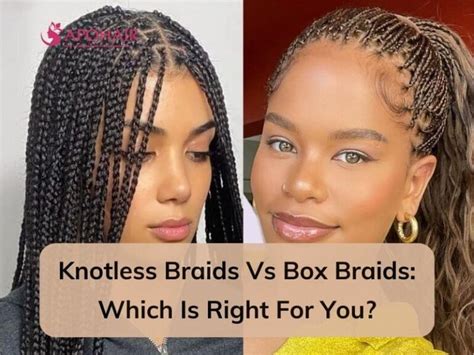Introduction

Braiding is a versatile hairstyling technique that can create various looks, from intricate cornrows to protective box braids. Two popular braiding methods are knotless braids and box braids, each offering unique advantages and challenges. This comprehensive guide will delve into the differences between knotless vs. box braids, empowering you to make an informed choice for your next protective hairstyle.
Knotless Braids
Pain Points
- Can be time-consuming to install, especially for longer hair.
- Some individuals may experience scalp tension due to the continuous pulling for knotless braids.
- Can be more expensive than box braids.
Motivations
- Less painful to install compared to box braids.
- Provides a natural, scalp-hugging look that can blend seamlessly with natural hair.
- Promotes hair growth by reducing tension on the hair follicles.
Benefits
- Long-lasting with minimal frizz and tangling.
- Suitable for all hair types and textures.
- Can be customized with various colors and styles to create a unique look.
Box Braids
Pain Points
- Installation can be painful due to the tight pulling and knotting involved.
- Can cause scalp irritation and breakage if braids are too tight.
- Prone to frizz and tangling, especially in humid environments.
Motivations
- More affordable than knotless braids.
- Quicker to install, especially for those with shorter hair.
- Can create a bold and dramatic look with a range of braid sizes.
Benefits
- Provides excellent protective styling for natural hair.
- Can be braided into a vast array of styles and designs.
- Ideal for achieving length and volume without damaging your own hair.
Table 1: Pain Comparison
| Braiding Method | Pain Level |
|—|—|—|
| Knotless Braids | Low-moderate |
| Box Braids | Moderate-high |
Table 2: Installation Time
| Braiding Method | Installation Time |
|—|—|—|
| Knotless Braids | 5-10 hours |
| Box Braids | 3-6 hours |
Table 3: Customizable Features
| Braiding Method | Customizable Features |
|—|—|—|
| Knotless Braids | Parting, size, color, texture |
| Box Braids | Parting, size, length, embellishments |
Table 4: Protective Styling
| Braiding Method | Protective Qualities |
|—|—|—|
| Knotless Braids | Moderate protection |
| Box Braids | High protection |
Common Mistakes to Avoid
- Braiding too tightly: Avoid excessive pulling to prevent scalp discomfort and hair damage.
- Using too much hairspray: Overuse of hairspray can leave braids stiff and unnatural.
- Neglecting scalp care: Wash and condition your scalp regularly to prevent dandruff and itching.
- Keeping braids in for too long: Limit the wearing time to 6-8 weeks to avoid matting and breakage.
Why It Matters
Choosing the right braiding method is crucial for achieving the desired look and maintaining healthy hair. Understanding the differences between knotless vs. box braids enables you to consider your pain tolerance, budget, and hair goals to make an informed decision that complements your lifestyle and aesthetics.
Benefits of Protective Braiding
- Provides a break from daily heat styling and chemical treatments.
- Helps seal in moisture and prevent dryness.
- Protects hair from environmental damage and breakage.
- Encourages hair growth by reducing manipulation and providing a growth-promoting environment.
Conclusion
Knotless and box braids offer distinct advantages and considerations. Knotless braids provide a more comfortable and natural look with less scalp tension, while box braids are faster to install and offer greater protective styling. By weighing the factors discussed in this article, you can choose the braiding method that best suits your personal preferences and hair care goals.
